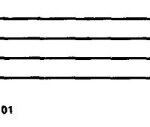Ford vehicles, like all modern cars, utilize the OBD2 (On-Board Diagnostics II) system to monitor emissions and diagnose potential problems. Understanding Ford Obd2 Trouble Codes is crucial for effective vehicle maintenance and repair. This guide provides insights into common Ford OBD2 codes, their causes, and potential solutions.
Understanding OBD2 Codes
OBD2 codes are standardized across vehicle manufacturers, consisting of a five-digit alphanumeric code. The first digit indicates the system related to the code:
- P: Powertrain (engine, transmission, and related components)
- B: Body (airbags, power seats, etc.)
- C: Chassis (ABS, steering, etc.)
- U: Network communication
The second digit specifies whether the code is generic (0) or manufacturer-specific (1). The third digit pinpoints the specific subsystem involved (e.g., fuel, ignition, emissions). The final two digits provide the exact fault code.
Common Ford OBD2 Trouble Codes
Several OBD2 codes frequently appear in Ford vehicles. Here are some examples:
- P0171 and P0174: These codes indicate a lean air/fuel mixture in bank 1 and bank 2, respectively. Potential causes include vacuum leaks, faulty oxygen sensors, or fuel system issues.
- P0300: This signifies a random or multiple cylinder misfire. Spark plugs, ignition coils, fuel injectors, or even low compression can trigger this code.
- P0401: This indicates insufficient EGR (Exhaust Gas Recirculation) flow. A clogged EGR valve, faulty EGR sensor, or vacuum leaks in the EGR system are common culprits.
- P0420: This code suggests catalyst system efficiency below threshold (Bank 1). A failing catalytic converter, faulty oxygen sensors, or exhaust leaks can cause this issue.
- P0442: This signifies a small EVAP (Evaporative Emission Control System) leak detected. A loose gas cap, damaged fuel tank or filler neck, or a faulty EVAP canister purge valve are potential causes.
Diagnosing Ford OBD2 Codes
While these are common Ford codes, many others can occur. Using an OBD2 scanner is the first step in diagnosis. The scanner retrieves the code from the vehicle’s computer, providing a starting point for troubleshooting.
Important Note: Don’t jump to conclusions based solely on the code. Thoroughly inspect related components, checking for vacuum leaks, damaged wiring, or faulty sensors. Consult a reliable Ford repair manual or online resources for detailed diagnostic procedures specific to your vehicle’s year and model.
Resolving Ford OBD2 Trouble Codes
Addressing Ford OBD2 trouble codes involves repairing or replacing the faulty component. Simple fixes, like tightening a gas cap or replacing spark plugs, may resolve some issues. However, more complex problems, such as a failing catalytic converter or a faulty transmission solenoid, require professional expertise.
Conclusion
Understanding Ford OBD2 trouble codes empowers car owners to proactively maintain their vehicles and address potential issues promptly. Using an OBD2 scanner, coupled with thorough diagnostic procedures, helps identify the root cause of problems. While some fixes are straightforward, others necessitate professional assistance. Regular vehicle maintenance and timely repairs contribute significantly to optimal performance, fuel efficiency, and a longer vehicle lifespan.

